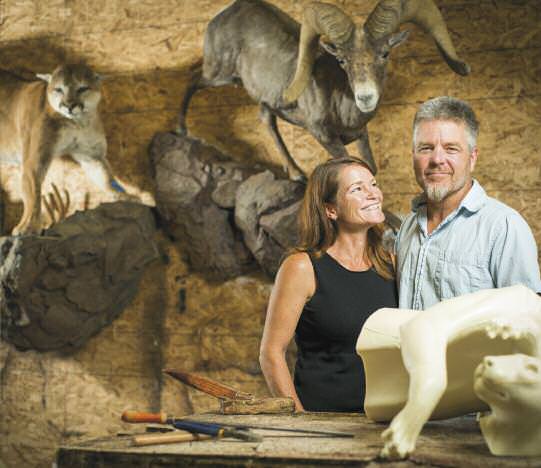feature
A WILD LIFE
Sean Shea shares the edible side of hunting.
WRITTEN BY ERIN MEYERING
PHOTOS BY CHRIS HOLLOMAN
Sean Shea wears many hats. He is a hunter, master guide, fisherman, and taxidermist, not to mention fishery biologist with the U.S. Geological Survey.
Shea grew up in Northwest Reno, “just a street away from the mountains,” he says. His interest in wildlife and the outdoors, in general, began early. He got his start with the USGS in the early ’90s, after he graduated from the University of Nevada, Reno with a degree in resource management.
Shea has since evolved into a serious mountain man, one who spends his days fishing, net and bow and arrow in hand, and returns home to walls showcasing taxidermy art.
Have bow, will travel
Now claiming to be “semi-retired,” Shea spends his time pretty much where he always has: outdoors. His guide and taxidermy business, The Head Master, which he started in 1990, still is going full swing.
The company’s taxidermy work emphasizes quality over quantity, as he limits the number of projects he takes on. On the hunting side, Shea shows small groups of people how to focus on the naturalistic qualities of hunting, so he can create a genuine and personal outdoor experience for them.
Opting to keep his own experience as natural as possible, this backwoodsman always hunts with a bow and arrow.
“Shooting with a rifle didn’t excite me as much as I thought it would,” Shea says.

Unusual tastes
Although Shea lives a rugged lifestyle by choice, he says he can’t remember a time when he has hunted and eaten anything that might be considered exotic, but then again, that’s likely because he’s used to eating mountain lion and beaver.
“If I shoot anything, I eat it,” Shea says.
He says that of the animals he hunts, mountain lion probably is his favorite to cook. Shea warns to not overcook it, though, because (like most meats) this can destroy the flavor. He admits, however, that he learned to cook the “not-so-supermarket meats” through trial and error.
Shea’s wife Vicky was a vegetarian when they met. But because she was an avid runner, she found she needed more lean protein in her diet. Shea laughs as he says that now she, too, cooks what he brings home, including mountain lion.
To the clients he takes hunting, he always stresses that whatever they shoot, they take home.
Ultimately, Shea’s goal is to encourage people to look around and not forget what we have here in terms of natural edible resources. He says that in our area, the animals are managed well, and that’s something to be thankful for.
For details on Sean Shea’s hunting tours, visit http://www.Seanshea.net or http://www.Theheadmaster.com
Erin Meyering is a recent graduate from the University of Nevada, Reno. Although originally from Southern California beach territory, she can appreciate the great outdoors, the beautiful scenery, and opportunity for activity that we have in our backyard.
Recipe
Mountain Lion Tacos
(courtesy of Sean Shea. Serves 4 to 5)
According to Shea, mountain lion meat can be used in place of pork in any meal. He uses the lean white meat in spaghetti sauce and fajitas.
About 2 pounds lion, which Shea refers to as “the other white meat”
¼ cup olive oil
½ teaspoon garlic salt
½ teaspoon garlic powder
2 medium yellow onions, chopped
1 green and 1 red bell pepper, thinly sliced into 4-inch lengths (yellow peppers also are nice)
Several garlic cloves, minced (add more if you’d like)
Salt or pepper, to taste (Shea doesn’t use any; it depends on personal taste)
Cut lion meat into ½-inch-wide and 4-inch-long strips.
Heat oil in skillet and add meat. Once meat starts to whiten, add remaining ingredients to the skillet (don’t overcook lion, as it is quite lean). Serve simmering in flour or corn tortillas, with toppings of your choice.


